An Analysis of Business Structures in the UK: Recommendations for SAM
VerifiedAdded on 2023/06/10
|11
|2776
|251
Report
AI Summary
This report provides a detailed analysis of various business structures prevalent in the UK, including sole proprietorships, general partnerships, limited liability partnerships (LLPs), and limited liability companies (LLCs). It explores the nature and management of companies, the legal frameworks governing them, and the roles and liabilities of directors. The report examines the advantages and disadvantages of each structure, covering aspects such as management, taxation, and legal considerations. The report also delves into the legal aspects, including the Companies Act 2006, and the importance of documents like the Memorandum and Articles of Association. Finally, the report offers recommendations for a business owner seeking to expand their operations, suggesting that an LLC structure may be most suitable for large-scale growth.
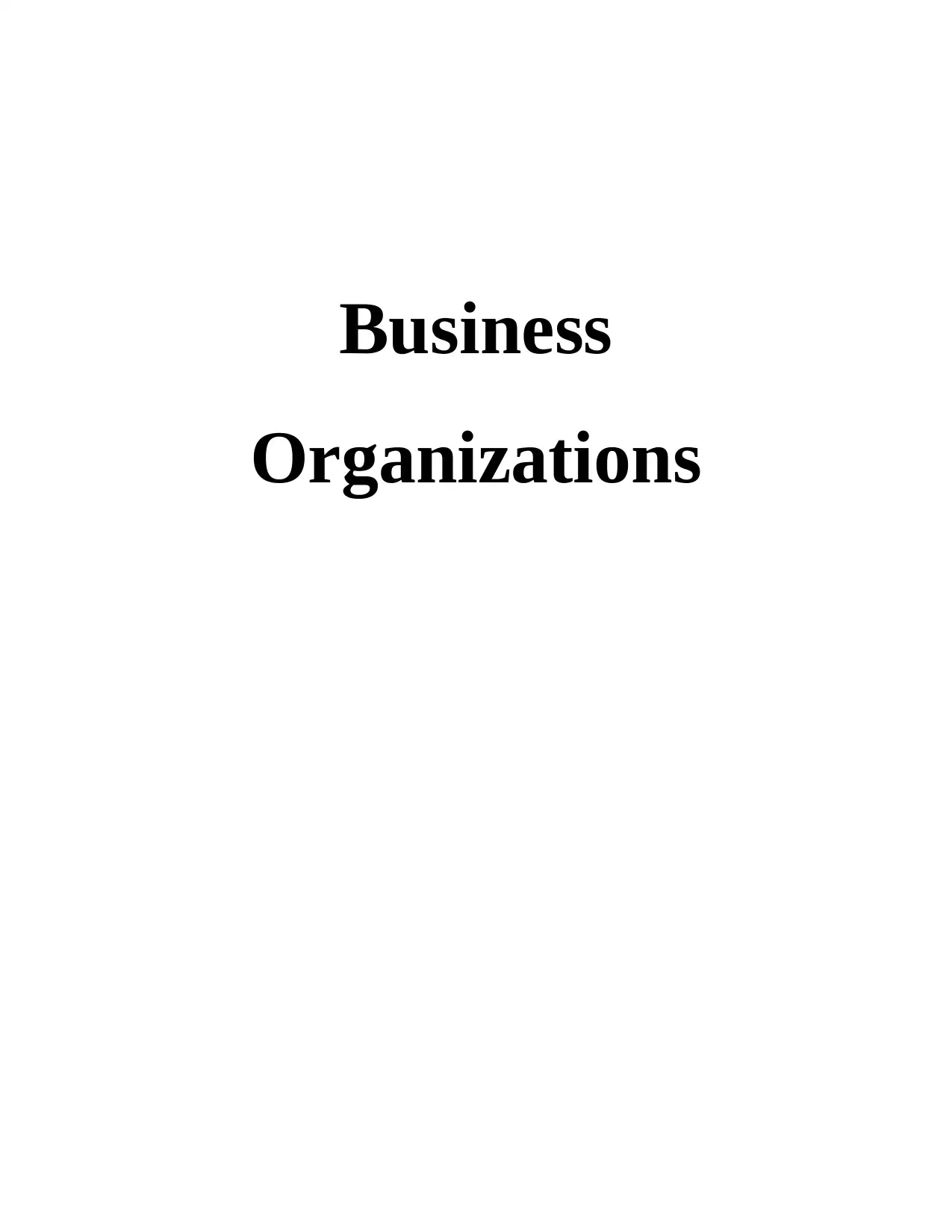
Business
Organizations
Organizations
Paraphrase This Document
Need a fresh take? Get an instant paraphrase of this document with our AI Paraphraser
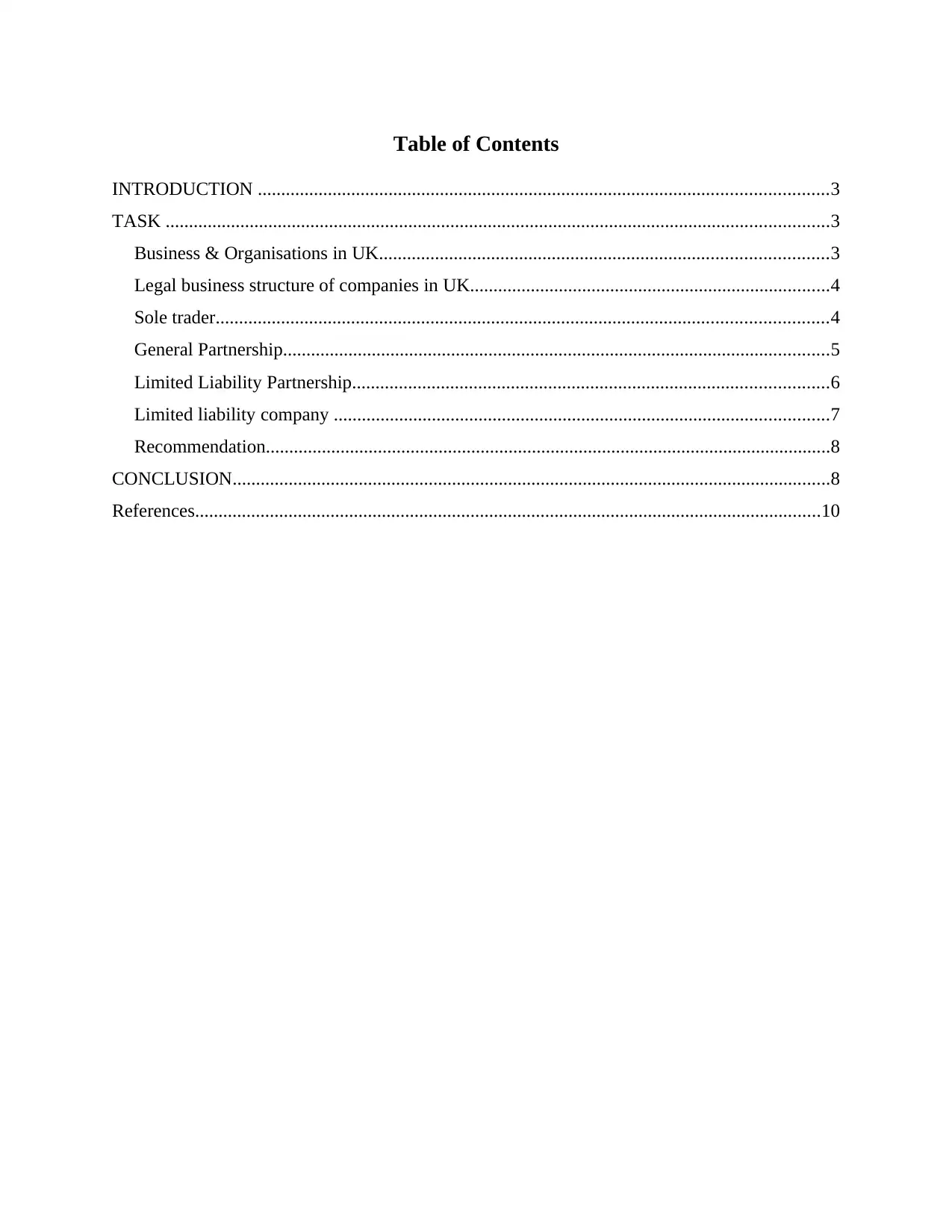
Table of Contents
INTRODUCTION ..........................................................................................................................3
TASK ..............................................................................................................................................3
Business & Organisations in UK................................................................................................3
Legal business structure of companies in UK.............................................................................4
Sole trader...................................................................................................................................4
General Partnership.....................................................................................................................5
Limited Liability Partnership......................................................................................................6
Limited liability company ..........................................................................................................7
Recommendation.........................................................................................................................8
CONCLUSION................................................................................................................................8
References......................................................................................................................................10
INTRODUCTION ..........................................................................................................................3
TASK ..............................................................................................................................................3
Business & Organisations in UK................................................................................................3
Legal business structure of companies in UK.............................................................................4
Sole trader...................................................................................................................................4
General Partnership.....................................................................................................................5
Limited Liability Partnership......................................................................................................6
Limited liability company ..........................................................................................................7
Recommendation.........................................................................................................................8
CONCLUSION................................................................................................................................8
References......................................................................................................................................10
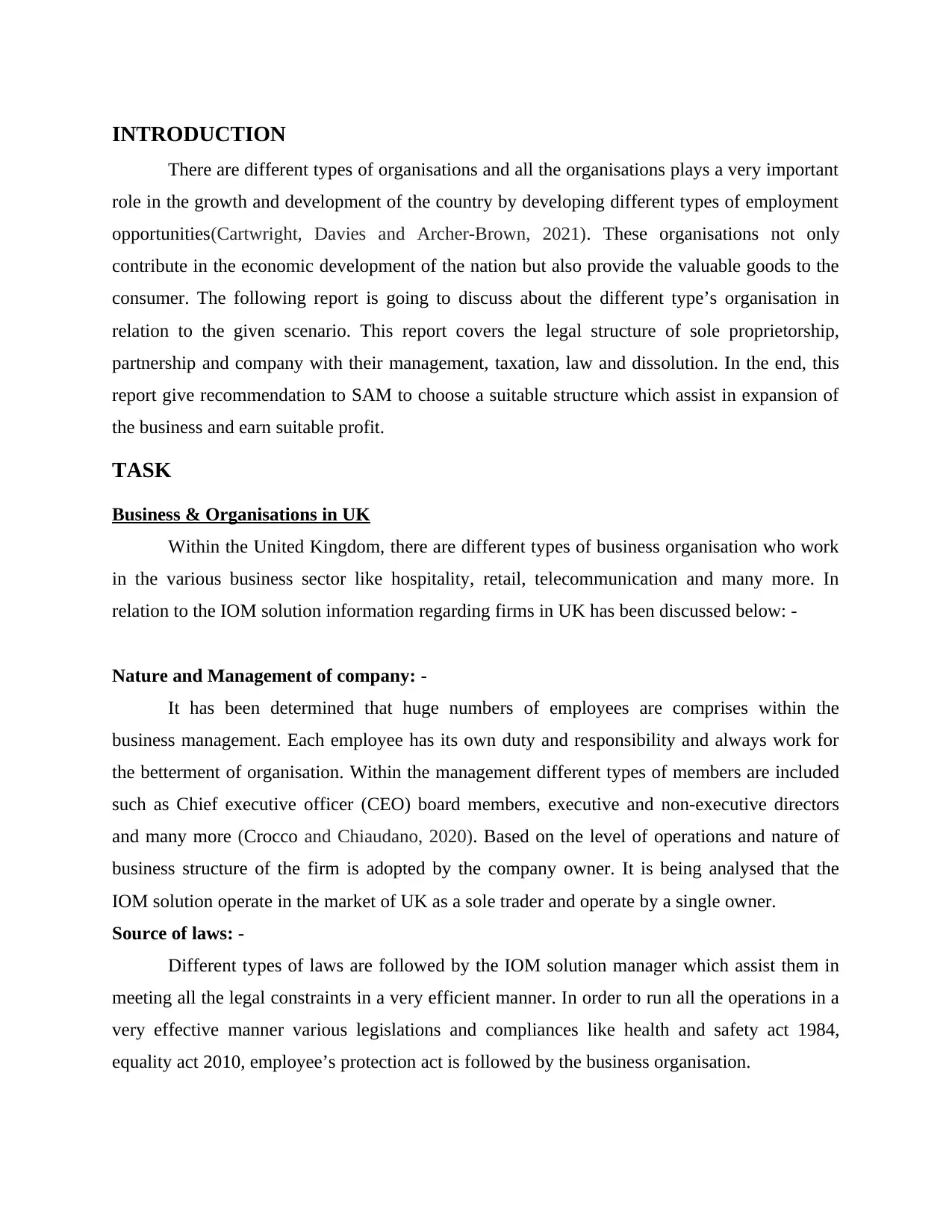
INTRODUCTION
There are different types of organisations and all the organisations plays a very important
role in the growth and development of the country by developing different types of employment
opportunities(Cartwright, Davies and Archer-Brown, 2021). These organisations not only
contribute in the economic development of the nation but also provide the valuable goods to the
consumer. The following report is going to discuss about the different type’s organisation in
relation to the given scenario. This report covers the legal structure of sole proprietorship,
partnership and company with their management, taxation, law and dissolution. In the end, this
report give recommendation to SAM to choose a suitable structure which assist in expansion of
the business and earn suitable profit.
TASK
Business & Organisations in UK
Within the United Kingdom, there are different types of business organisation who work
in the various business sector like hospitality, retail, telecommunication and many more. In
relation to the IOM solution information regarding firms in UK has been discussed below: -
Nature and Management of company: -
It has been determined that huge numbers of employees are comprises within the
business management. Each employee has its own duty and responsibility and always work for
the betterment of organisation. Within the management different types of members are included
such as Chief executive officer (CEO) board members, executive and non-executive directors
and many more (Crocco and Chiaudano, 2020). Based on the level of operations and nature of
business structure of the firm is adopted by the company owner. It is being analysed that the
IOM solution operate in the market of UK as a sole trader and operate by a single owner.
Source of laws: -
Different types of laws are followed by the IOM solution manager which assist them in
meeting all the legal constraints in a very efficient manner. In order to run all the operations in a
very effective manner various legislations and compliances like health and safety act 1984,
equality act 2010, employee’s protection act is followed by the business organisation.
There are different types of organisations and all the organisations plays a very important
role in the growth and development of the country by developing different types of employment
opportunities(Cartwright, Davies and Archer-Brown, 2021). These organisations not only
contribute in the economic development of the nation but also provide the valuable goods to the
consumer. The following report is going to discuss about the different type’s organisation in
relation to the given scenario. This report covers the legal structure of sole proprietorship,
partnership and company with their management, taxation, law and dissolution. In the end, this
report give recommendation to SAM to choose a suitable structure which assist in expansion of
the business and earn suitable profit.
TASK
Business & Organisations in UK
Within the United Kingdom, there are different types of business organisation who work
in the various business sector like hospitality, retail, telecommunication and many more. In
relation to the IOM solution information regarding firms in UK has been discussed below: -
Nature and Management of company: -
It has been determined that huge numbers of employees are comprises within the
business management. Each employee has its own duty and responsibility and always work for
the betterment of organisation. Within the management different types of members are included
such as Chief executive officer (CEO) board members, executive and non-executive directors
and many more (Crocco and Chiaudano, 2020). Based on the level of operations and nature of
business structure of the firm is adopted by the company owner. It is being analysed that the
IOM solution operate in the market of UK as a sole trader and operate by a single owner.
Source of laws: -
Different types of laws are followed by the IOM solution manager which assist them in
meeting all the legal constraints in a very efficient manner. In order to run all the operations in a
very effective manner various legislations and compliances like health and safety act 1984,
equality act 2010, employee’s protection act is followed by the business organisation.
⊘ This is a preview!⊘
Do you want full access?
Subscribe today to unlock all pages.

Trusted by 1+ million students worldwide
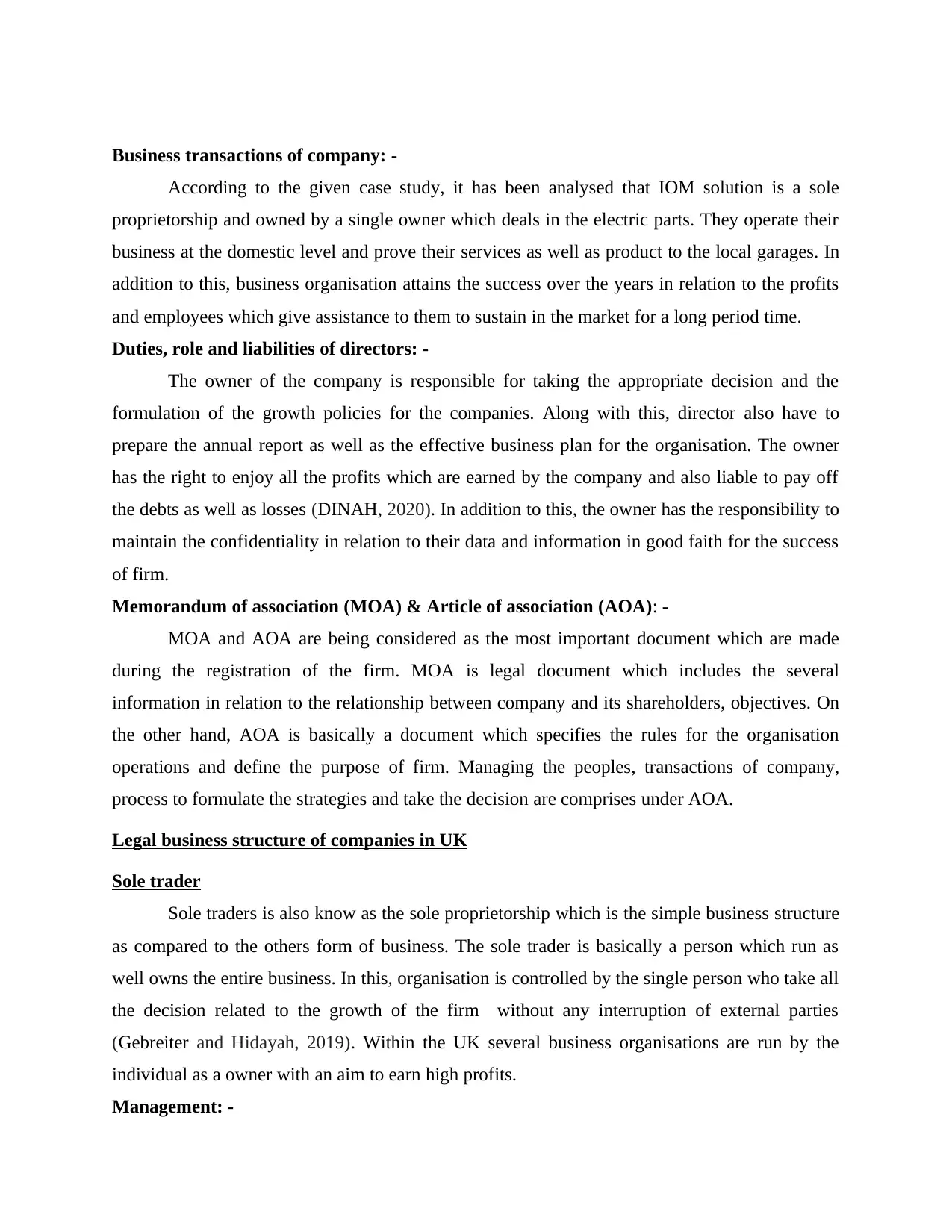
Business transactions of company: -
According to the given case study, it has been analysed that IOM solution is a sole
proprietorship and owned by a single owner which deals in the electric parts. They operate their
business at the domestic level and prove their services as well as product to the local garages. In
addition to this, business organisation attains the success over the years in relation to the profits
and employees which give assistance to them to sustain in the market for a long period time.
Duties, role and liabilities of directors: -
The owner of the company is responsible for taking the appropriate decision and the
formulation of the growth policies for the companies. Along with this, director also have to
prepare the annual report as well as the effective business plan for the organisation. The owner
has the right to enjoy all the profits which are earned by the company and also liable to pay off
the debts as well as losses (DINAH, 2020). In addition to this, the owner has the responsibility to
maintain the confidentiality in relation to their data and information in good faith for the success
of firm.
Memorandum of association (MOA) & Article of association (AOA): -
MOA and AOA are being considered as the most important document which are made
during the registration of the firm. MOA is legal document which includes the several
information in relation to the relationship between company and its shareholders, objectives. On
the other hand, AOA is basically a document which specifies the rules for the organisation
operations and define the purpose of firm. Managing the peoples, transactions of company,
process to formulate the strategies and take the decision are comprises under AOA.
Legal business structure of companies in UK
Sole trader
Sole traders is also know as the sole proprietorship which is the simple business structure
as compared to the others form of business. The sole trader is basically a person which run as
well owns the entire business. In this, organisation is controlled by the single person who take all
the decision related to the growth of the firm without any interruption of external parties
(Gebreiter and Hidayah, 2019). Within the UK several business organisations are run by the
individual as a owner with an aim to earn high profits.
Management: -
According to the given case study, it has been analysed that IOM solution is a sole
proprietorship and owned by a single owner which deals in the electric parts. They operate their
business at the domestic level and prove their services as well as product to the local garages. In
addition to this, business organisation attains the success over the years in relation to the profits
and employees which give assistance to them to sustain in the market for a long period time.
Duties, role and liabilities of directors: -
The owner of the company is responsible for taking the appropriate decision and the
formulation of the growth policies for the companies. Along with this, director also have to
prepare the annual report as well as the effective business plan for the organisation. The owner
has the right to enjoy all the profits which are earned by the company and also liable to pay off
the debts as well as losses (DINAH, 2020). In addition to this, the owner has the responsibility to
maintain the confidentiality in relation to their data and information in good faith for the success
of firm.
Memorandum of association (MOA) & Article of association (AOA): -
MOA and AOA are being considered as the most important document which are made
during the registration of the firm. MOA is legal document which includes the several
information in relation to the relationship between company and its shareholders, objectives. On
the other hand, AOA is basically a document which specifies the rules for the organisation
operations and define the purpose of firm. Managing the peoples, transactions of company,
process to formulate the strategies and take the decision are comprises under AOA.
Legal business structure of companies in UK
Sole trader
Sole traders is also know as the sole proprietorship which is the simple business structure
as compared to the others form of business. The sole trader is basically a person which run as
well owns the entire business. In this, organisation is controlled by the single person who take all
the decision related to the growth of the firm without any interruption of external parties
(Gebreiter and Hidayah, 2019). Within the UK several business organisations are run by the
individual as a owner with an aim to earn high profits.
Management: -
Paraphrase This Document
Need a fresh take? Get an instant paraphrase of this document with our AI Paraphraser
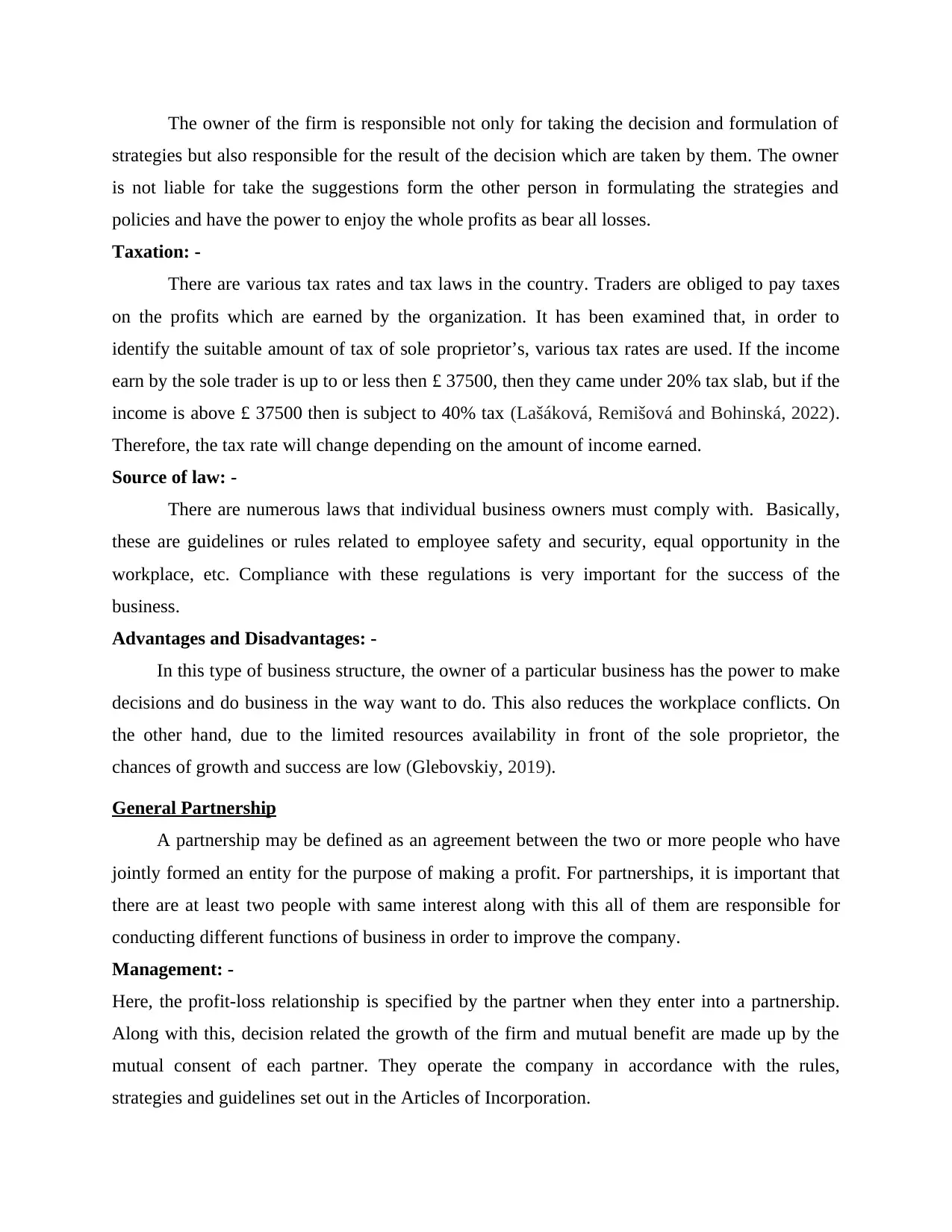
The owner of the firm is responsible not only for taking the decision and formulation of
strategies but also responsible for the result of the decision which are taken by them. The owner
is not liable for take the suggestions form the other person in formulating the strategies and
policies and have the power to enjoy the whole profits as bear all losses.
Taxation: -
There are various tax rates and tax laws in the country. Traders are obliged to pay taxes
on the profits which are earned by the organization. It has been examined that, in order to
identify the suitable amount of tax of sole proprietor’s, various tax rates are used. If the income
earn by the sole trader is up to or less then £ 37500, then they came under 20% tax slab, but if the
income is above £ 37500 then is subject to 40% tax (Lašáková, Remišová and Bohinská, 2022).
Therefore, the tax rate will change depending on the amount of income earned.
Source of law: -
There are numerous laws that individual business owners must comply with. Basically,
these are guidelines or rules related to employee safety and security, equal opportunity in the
workplace, etc. Compliance with these regulations is very important for the success of the
business.
Advantages and Disadvantages: -
In this type of business structure, the owner of a particular business has the power to make
decisions and do business in the way want to do. This also reduces the workplace conflicts. On
the other hand, due to the limited resources availability in front of the sole proprietor, the
chances of growth and success are low (Glebovskiy, 2019).
General Partnership
A partnership may be defined as an agreement between the two or more people who have
jointly formed an entity for the purpose of making a profit. For partnerships, it is important that
there are at least two people with same interest along with this all of them are responsible for
conducting different functions of business in order to improve the company.
Management: -
Here, the profit-loss relationship is specified by the partner when they enter into a partnership.
Along with this, decision related the growth of the firm and mutual benefit are made up by the
mutual consent of each partner. They operate the company in accordance with the rules,
strategies and guidelines set out in the Articles of Incorporation.
strategies but also responsible for the result of the decision which are taken by them. The owner
is not liable for take the suggestions form the other person in formulating the strategies and
policies and have the power to enjoy the whole profits as bear all losses.
Taxation: -
There are various tax rates and tax laws in the country. Traders are obliged to pay taxes
on the profits which are earned by the organization. It has been examined that, in order to
identify the suitable amount of tax of sole proprietor’s, various tax rates are used. If the income
earn by the sole trader is up to or less then £ 37500, then they came under 20% tax slab, but if the
income is above £ 37500 then is subject to 40% tax (Lašáková, Remišová and Bohinská, 2022).
Therefore, the tax rate will change depending on the amount of income earned.
Source of law: -
There are numerous laws that individual business owners must comply with. Basically,
these are guidelines or rules related to employee safety and security, equal opportunity in the
workplace, etc. Compliance with these regulations is very important for the success of the
business.
Advantages and Disadvantages: -
In this type of business structure, the owner of a particular business has the power to make
decisions and do business in the way want to do. This also reduces the workplace conflicts. On
the other hand, due to the limited resources availability in front of the sole proprietor, the
chances of growth and success are low (Glebovskiy, 2019).
General Partnership
A partnership may be defined as an agreement between the two or more people who have
jointly formed an entity for the purpose of making a profit. For partnerships, it is important that
there are at least two people with same interest along with this all of them are responsible for
conducting different functions of business in order to improve the company.
Management: -
Here, the profit-loss relationship is specified by the partner when they enter into a partnership.
Along with this, decision related the growth of the firm and mutual benefit are made up by the
mutual consent of each partner. They operate the company in accordance with the rules,
strategies and guidelines set out in the Articles of Incorporation.
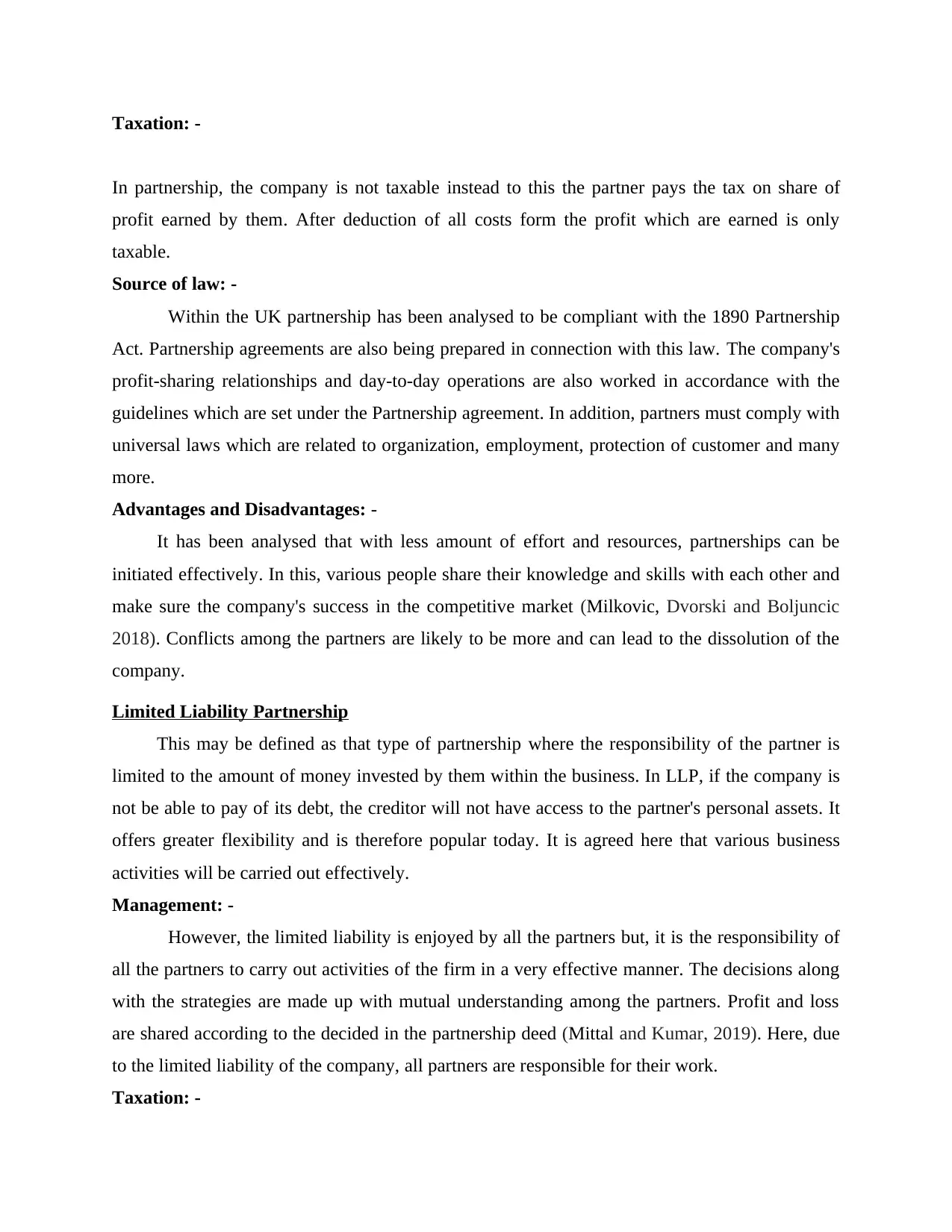
Taxation: -
In partnership, the company is not taxable instead to this the partner pays the tax on share of
profit earned by them. After deduction of all costs form the profit which are earned is only
taxable.
Source of law: -
Within the UK partnership has been analysed to be compliant with the 1890 Partnership
Act. Partnership agreements are also being prepared in connection with this law. The company's
profit-sharing relationships and day-to-day operations are also worked in accordance with the
guidelines which are set under the Partnership agreement. In addition, partners must comply with
universal laws which are related to organization, employment, protection of customer and many
more.
Advantages and Disadvantages: -
It has been analysed that with less amount of effort and resources, partnerships can be
initiated effectively. In this, various people share their knowledge and skills with each other and
make sure the company's success in the competitive market (Milkovic, Dvorski and Boljuncic
2018). Conflicts among the partners are likely to be more and can lead to the dissolution of the
company.
Limited Liability Partnership
This may be defined as that type of partnership where the responsibility of the partner is
limited to the amount of money invested by them within the business. In LLP, if the company is
not be able to pay of its debt, the creditor will not have access to the partner's personal assets. It
offers greater flexibility and is therefore popular today. It is agreed here that various business
activities will be carried out effectively.
Management: -
However, the limited liability is enjoyed by all the partners but, it is the responsibility of
all the partners to carry out activities of the firm in a very effective manner. The decisions along
with the strategies are made up with mutual understanding among the partners. Profit and loss
are shared according to the decided in the partnership deed (Mittal and Kumar, 2019). Here, due
to the limited liability of the company, all partners are responsible for their work.
Taxation: -
In partnership, the company is not taxable instead to this the partner pays the tax on share of
profit earned by them. After deduction of all costs form the profit which are earned is only
taxable.
Source of law: -
Within the UK partnership has been analysed to be compliant with the 1890 Partnership
Act. Partnership agreements are also being prepared in connection with this law. The company's
profit-sharing relationships and day-to-day operations are also worked in accordance with the
guidelines which are set under the Partnership agreement. In addition, partners must comply with
universal laws which are related to organization, employment, protection of customer and many
more.
Advantages and Disadvantages: -
It has been analysed that with less amount of effort and resources, partnerships can be
initiated effectively. In this, various people share their knowledge and skills with each other and
make sure the company's success in the competitive market (Milkovic, Dvorski and Boljuncic
2018). Conflicts among the partners are likely to be more and can lead to the dissolution of the
company.
Limited Liability Partnership
This may be defined as that type of partnership where the responsibility of the partner is
limited to the amount of money invested by them within the business. In LLP, if the company is
not be able to pay of its debt, the creditor will not have access to the partner's personal assets. It
offers greater flexibility and is therefore popular today. It is agreed here that various business
activities will be carried out effectively.
Management: -
However, the limited liability is enjoyed by all the partners but, it is the responsibility of
all the partners to carry out activities of the firm in a very effective manner. The decisions along
with the strategies are made up with mutual understanding among the partners. Profit and loss
are shared according to the decided in the partnership deed (Mittal and Kumar, 2019). Here, due
to the limited liability of the company, all partners are responsible for their work.
Taxation: -
⊘ This is a preview!⊘
Do you want full access?
Subscribe today to unlock all pages.

Trusted by 1+ million students worldwide
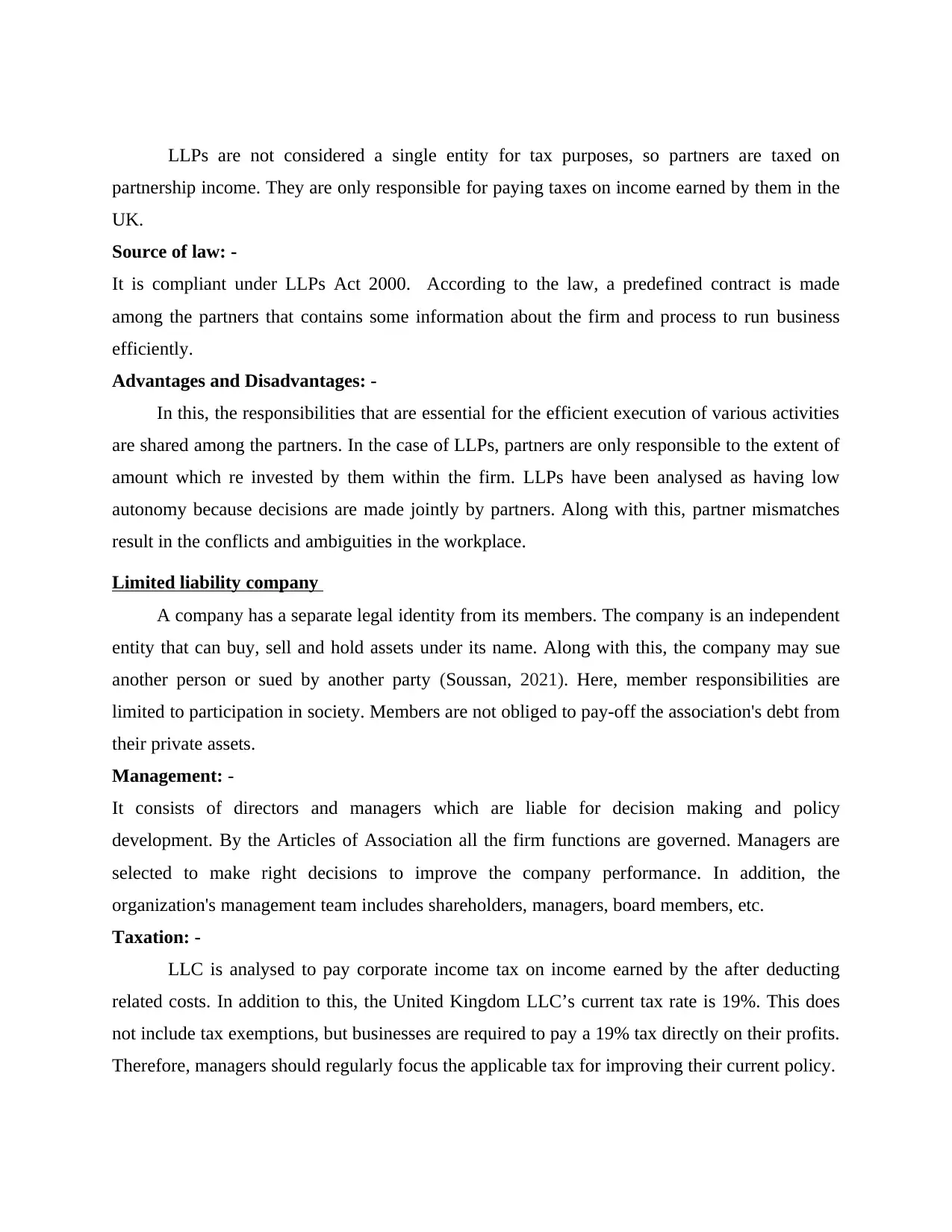
LLPs are not considered a single entity for tax purposes, so partners are taxed on
partnership income. They are only responsible for paying taxes on income earned by them in the
UK.
Source of law: -
It is compliant under LLPs Act 2000. According to the law, a predefined contract is made
among the partners that contains some information about the firm and process to run business
efficiently.
Advantages and Disadvantages: -
In this, the responsibilities that are essential for the efficient execution of various activities
are shared among the partners. In the case of LLPs, partners are only responsible to the extent of
amount which re invested by them within the firm. LLPs have been analysed as having low
autonomy because decisions are made jointly by partners. Along with this, partner mismatches
result in the conflicts and ambiguities in the workplace.
Limited liability company
A company has a separate legal identity from its members. The company is an independent
entity that can buy, sell and hold assets under its name. Along with this, the company may sue
another person or sued by another party (Soussan, 2021). Here, member responsibilities are
limited to participation in society. Members are not obliged to pay-off the association's debt from
their private assets.
Management: -
It consists of directors and managers which are liable for decision making and policy
development. By the Articles of Association all the firm functions are governed. Managers are
selected to make right decisions to improve the company performance. In addition, the
organization's management team includes shareholders, managers, board members, etc.
Taxation: -
LLC is analysed to pay corporate income tax on income earned by the after deducting
related costs. In addition to this, the United Kingdom LLC’s current tax rate is 19%. This does
not include tax exemptions, but businesses are required to pay a 19% tax directly on their profits.
Therefore, managers should regularly focus the applicable tax for improving their current policy.
partnership income. They are only responsible for paying taxes on income earned by them in the
UK.
Source of law: -
It is compliant under LLPs Act 2000. According to the law, a predefined contract is made
among the partners that contains some information about the firm and process to run business
efficiently.
Advantages and Disadvantages: -
In this, the responsibilities that are essential for the efficient execution of various activities
are shared among the partners. In the case of LLPs, partners are only responsible to the extent of
amount which re invested by them within the firm. LLPs have been analysed as having low
autonomy because decisions are made jointly by partners. Along with this, partner mismatches
result in the conflicts and ambiguities in the workplace.
Limited liability company
A company has a separate legal identity from its members. The company is an independent
entity that can buy, sell and hold assets under its name. Along with this, the company may sue
another person or sued by another party (Soussan, 2021). Here, member responsibilities are
limited to participation in society. Members are not obliged to pay-off the association's debt from
their private assets.
Management: -
It consists of directors and managers which are liable for decision making and policy
development. By the Articles of Association all the firm functions are governed. Managers are
selected to make right decisions to improve the company performance. In addition, the
organization's management team includes shareholders, managers, board members, etc.
Taxation: -
LLC is analysed to pay corporate income tax on income earned by the after deducting
related costs. In addition to this, the United Kingdom LLC’s current tax rate is 19%. This does
not include tax exemptions, but businesses are required to pay a 19% tax directly on their profits.
Therefore, managers should regularly focus the applicable tax for improving their current policy.
Paraphrase This Document
Need a fresh take? Get an instant paraphrase of this document with our AI Paraphraser
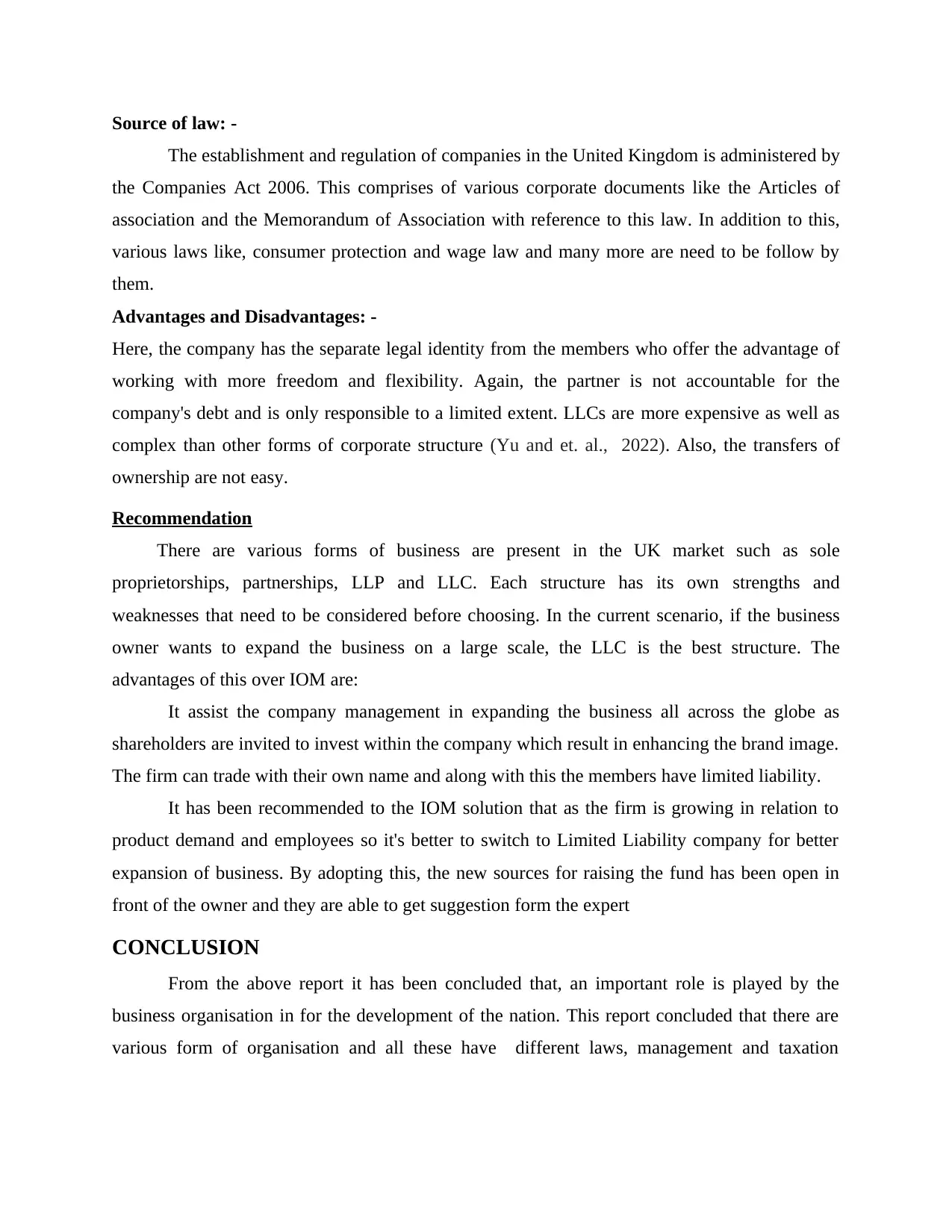
Source of law: -
The establishment and regulation of companies in the United Kingdom is administered by
the Companies Act 2006. This comprises of various corporate documents like the Articles of
association and the Memorandum of Association with reference to this law. In addition to this,
various laws like, consumer protection and wage law and many more are need to be follow by
them.
Advantages and Disadvantages: -
Here, the company has the separate legal identity from the members who offer the advantage of
working with more freedom and flexibility. Again, the partner is not accountable for the
company's debt and is only responsible to a limited extent. LLCs are more expensive as well as
complex than other forms of corporate structure (Yu and et. al., 2022). Also, the transfers of
ownership are not easy.
Recommendation
There are various forms of business are present in the UK market such as sole
proprietorships, partnerships, LLP and LLC. Each structure has its own strengths and
weaknesses that need to be considered before choosing. In the current scenario, if the business
owner wants to expand the business on a large scale, the LLC is the best structure. The
advantages of this over IOM are:
It assist the company management in expanding the business all across the globe as
shareholders are invited to invest within the company which result in enhancing the brand image.
The firm can trade with their own name and along with this the members have limited liability.
It has been recommended to the IOM solution that as the firm is growing in relation to
product demand and employees so it's better to switch to Limited Liability company for better
expansion of business. By adopting this, the new sources for raising the fund has been open in
front of the owner and they are able to get suggestion form the expert
CONCLUSION
From the above report it has been concluded that, an important role is played by the
business organisation in for the development of the nation. This report concluded that there are
various form of organisation and all these have different laws, management and taxation
The establishment and regulation of companies in the United Kingdom is administered by
the Companies Act 2006. This comprises of various corporate documents like the Articles of
association and the Memorandum of Association with reference to this law. In addition to this,
various laws like, consumer protection and wage law and many more are need to be follow by
them.
Advantages and Disadvantages: -
Here, the company has the separate legal identity from the members who offer the advantage of
working with more freedom and flexibility. Again, the partner is not accountable for the
company's debt and is only responsible to a limited extent. LLCs are more expensive as well as
complex than other forms of corporate structure (Yu and et. al., 2022). Also, the transfers of
ownership are not easy.
Recommendation
There are various forms of business are present in the UK market such as sole
proprietorships, partnerships, LLP and LLC. Each structure has its own strengths and
weaknesses that need to be considered before choosing. In the current scenario, if the business
owner wants to expand the business on a large scale, the LLC is the best structure. The
advantages of this over IOM are:
It assist the company management in expanding the business all across the globe as
shareholders are invited to invest within the company which result in enhancing the brand image.
The firm can trade with their own name and along with this the members have limited liability.
It has been recommended to the IOM solution that as the firm is growing in relation to
product demand and employees so it's better to switch to Limited Liability company for better
expansion of business. By adopting this, the new sources for raising the fund has been open in
front of the owner and they are able to get suggestion form the expert
CONCLUSION
From the above report it has been concluded that, an important role is played by the
business organisation in for the development of the nation. This report concluded that there are
various form of organisation and all these have different laws, management and taxation

regulations. More over to this, this report also concluded the advantages as well as disadvantages
of each structure.
of each structure.
⊘ This is a preview!⊘
Do you want full access?
Subscribe today to unlock all pages.

Trusted by 1+ million students worldwide
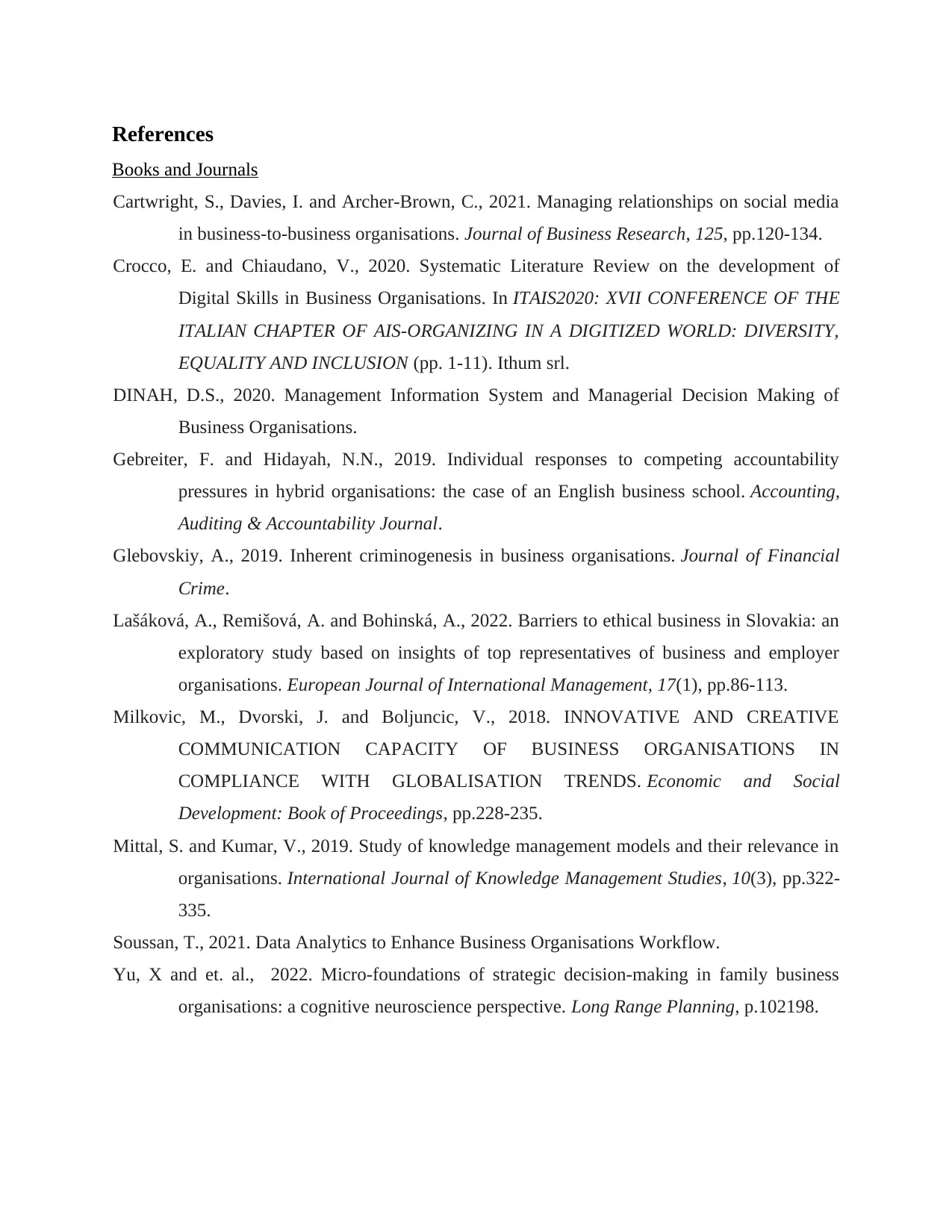
References
Books and Journals
Cartwright, S., Davies, I. and Archer-Brown, C., 2021. Managing relationships on social media
in business-to-business organisations. Journal of Business Research, 125, pp.120-134.
Crocco, E. and Chiaudano, V., 2020. Systematic Literature Review on the development of
Digital Skills in Business Organisations. In ITAIS2020: XVII CONFERENCE OF THE
ITALIAN CHAPTER OF AIS-ORGANIZING IN A DIGITIZED WORLD: DIVERSITY,
EQUALITY AND INCLUSION (pp. 1-11). Ithum srl.
DINAH, D.S., 2020. Management Information System and Managerial Decision Making of
Business Organisations.
Gebreiter, F. and Hidayah, N.N., 2019. Individual responses to competing accountability
pressures in hybrid organisations: the case of an English business school. Accounting,
Auditing & Accountability Journal.
Glebovskiy, A., 2019. Inherent criminogenesis in business organisations. Journal of Financial
Crime.
Lašáková, A., Remišová, A. and Bohinská, A., 2022. Barriers to ethical business in Slovakia: an
exploratory study based on insights of top representatives of business and employer
organisations. European Journal of International Management, 17(1), pp.86-113.
Milkovic, M., Dvorski, J. and Boljuncic, V., 2018. INNOVATIVE AND CREATIVE
COMMUNICATION CAPACITY OF BUSINESS ORGANISATIONS IN
COMPLIANCE WITH GLOBALISATION TRENDS. Economic and Social
Development: Book of Proceedings, pp.228-235.
Mittal, S. and Kumar, V., 2019. Study of knowledge management models and their relevance in
organisations. International Journal of Knowledge Management Studies, 10(3), pp.322-
335.
Soussan, T., 2021. Data Analytics to Enhance Business Organisations Workflow.
Yu, X and et. al., 2022. Micro-foundations of strategic decision-making in family business
organisations: a cognitive neuroscience perspective. Long Range Planning, p.102198.
Books and Journals
Cartwright, S., Davies, I. and Archer-Brown, C., 2021. Managing relationships on social media
in business-to-business organisations. Journal of Business Research, 125, pp.120-134.
Crocco, E. and Chiaudano, V., 2020. Systematic Literature Review on the development of
Digital Skills in Business Organisations. In ITAIS2020: XVII CONFERENCE OF THE
ITALIAN CHAPTER OF AIS-ORGANIZING IN A DIGITIZED WORLD: DIVERSITY,
EQUALITY AND INCLUSION (pp. 1-11). Ithum srl.
DINAH, D.S., 2020. Management Information System and Managerial Decision Making of
Business Organisations.
Gebreiter, F. and Hidayah, N.N., 2019. Individual responses to competing accountability
pressures in hybrid organisations: the case of an English business school. Accounting,
Auditing & Accountability Journal.
Glebovskiy, A., 2019. Inherent criminogenesis in business organisations. Journal of Financial
Crime.
Lašáková, A., Remišová, A. and Bohinská, A., 2022. Barriers to ethical business in Slovakia: an
exploratory study based on insights of top representatives of business and employer
organisations. European Journal of International Management, 17(1), pp.86-113.
Milkovic, M., Dvorski, J. and Boljuncic, V., 2018. INNOVATIVE AND CREATIVE
COMMUNICATION CAPACITY OF BUSINESS ORGANISATIONS IN
COMPLIANCE WITH GLOBALISATION TRENDS. Economic and Social
Development: Book of Proceedings, pp.228-235.
Mittal, S. and Kumar, V., 2019. Study of knowledge management models and their relevance in
organisations. International Journal of Knowledge Management Studies, 10(3), pp.322-
335.
Soussan, T., 2021. Data Analytics to Enhance Business Organisations Workflow.
Yu, X and et. al., 2022. Micro-foundations of strategic decision-making in family business
organisations: a cognitive neuroscience perspective. Long Range Planning, p.102198.
Paraphrase This Document
Need a fresh take? Get an instant paraphrase of this document with our AI Paraphraser

1 out of 11
Related Documents
Your All-in-One AI-Powered Toolkit for Academic Success.
+13062052269
info@desklib.com
Available 24*7 on WhatsApp / Email
![[object Object]](/_next/static/media/star-bottom.7253800d.svg)
Unlock your academic potential
Copyright © 2020–2025 A2Z Services. All Rights Reserved. Developed and managed by ZUCOL.



